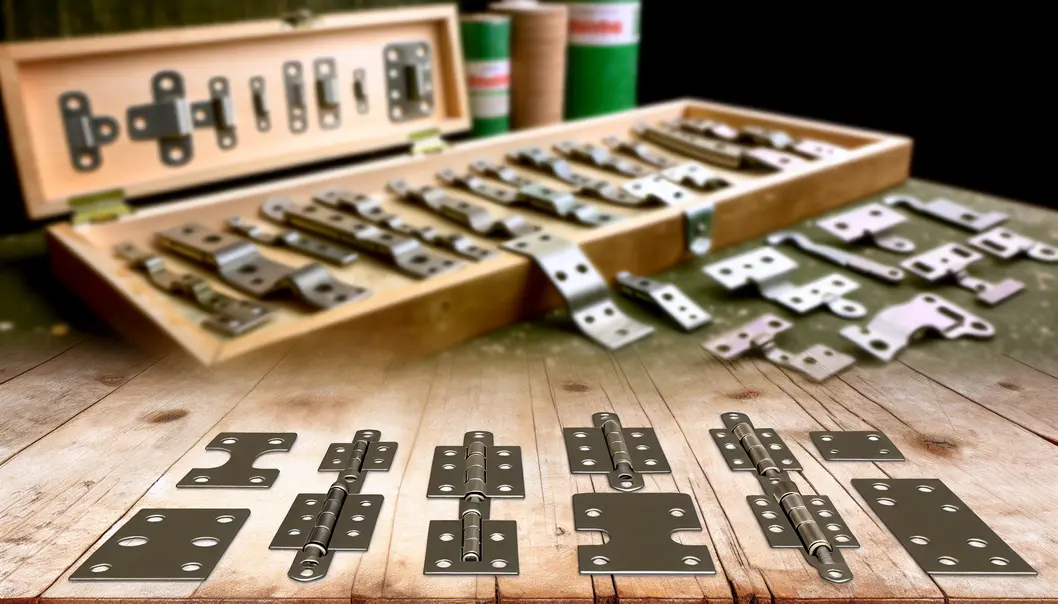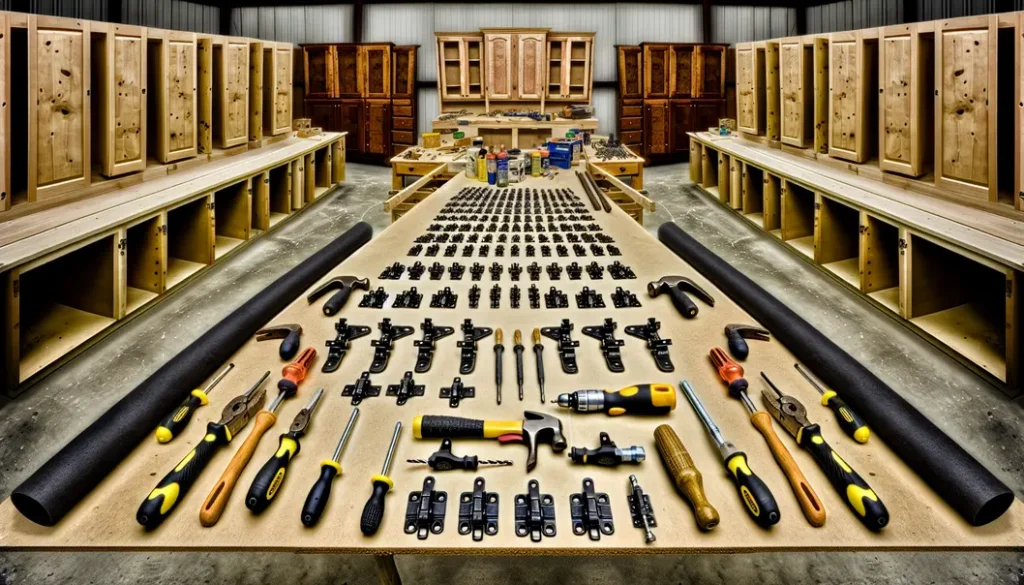Choosing the right cabinet hinges is crucial for both functionality and aesthetics in your home improvement projects. Whether installing new cabinets or upgrading existing ones, understanding the types of hinges available and their installation processes can significantly impact the outcome. For homeowners and enthusiastic DIYers, delving into the world of cabinet hinges unveils a variety of styles and features that influence how cabinets operate and integrate with your decor. Join us as we uncover the essential components that transform ordinary cabinets into functional and beautiful assets of your home.
Understanding Cabinet Hinge Types

Cabinet hinges may seem like a minor detail, but they are crucial to the functionality and aesthetics of cabinetry. Understanding the different types of cabinet hinges is essential for anyone aiming to elevate their cabinet craftsmanship. The three primary types of cabinet hinges include concealed, semi-concealed, and exposed hinges, each offering unique benefits and applications.
Concealed hinges, also known as European hinges, are hidden when the cabinet door is closed, offering a sleek, modern look. They are popular for contemporary cabinetry designs where a seamless appearance is desired. Concealed hinges allow for incremental adjustments, ensuring precise alignment. This type of hinge often comes with a soft-close feature, which gently slows the door as it closes, reducing wear and tear.
Semi-concealed hinges are partially visible when the cabinet door is closed. They offer a blend of traditional and modern aesthetics, making them suitable for a variety of design styles. Typically, the hinge arm is hidden while the hinge plate is visible, adding a subtle decorative element. Semi-concealed hinges are often more budget-friendly than fully concealed options, providing a practical middle ground for many homeowners.
Exposed hinges are entirely visible when the cabinet door is closed, making them a prominent element of the cabinet’s design. They come in a variety of styles, from classic to ornate, allowing for customization in traditional and antique-inspired designs. Exposed hinges are often used in furniture-style cabinetry, where the hinge’s decorative features enhance the overall aesthetic.
Selecting the appropriate hinge type involves considering not only the visual impact but also the functional needs of the cabinet. Each type presents its own set of installation techniques and maintenance requirements. For those looking to transform their homes into spaces that promote physical and mental well-being, understanding these details is crucial. For further how-to inspiration on creating a healthy home, consider exploring resources such as Creating a Healthy Home for a Healthy Mind. By mastering the intricacies of cabinet hinges, you can ensure that the choice you make harmonizes your cabinetry’s functionality with its aesthetic appeal.
Selecting the Right Hinges for Your Project

Choosing the perfect hinges for your cabinetry projects requires more than simply opting for any set from your local hardware store. The right hinge plays a crucial role in both functionality and aesthetic appeal. Begin by considering the size of your cabinet doors. Inadequate sizing can lead to operational issues, while oversizing might overshadow your design. Measure your cabinet dimensions carefully and match them with hinges that offer precise functionality and support.
Material selection is equally pivotal in determining the longevity and resilience of your hinges. Common materials include stainless steel, brass, and nickel. Stainless steel offers strength and durability, making it ideal for heavy doors or areas prone to moisture, such as kitchens and bathrooms. Brass, on the other hand, provides an elegant touch and suits traditional designs. Understand that material choice affects not only durability but also how well the hinge blends with your cabinetry style.
The finish of your hinge further elevates the overall look of your cabinets. Whether polished, satin, or antique, the finish can harmonize or contrast with other elements in your room. Consider coordinating the hinge finish with handles, knobs, and other fixtures. Achieving this synchronization can bring unity and elegance to your cabinetry. Experiment with different finishes if you’re aiming for a unique or customized look.
Durability and style do not exist in a vacuum. It’s crucial to align your hinge choice with the specific cabinetry needs. For instance, a decorative hinge might suit a living room display cabinet but not a kitchen setting subjected to high traffic and frequent cleaning. Concealed hinges provide a seamless look but require precise installation, while semi-concealed or exposed varieties offer different aesthetic benefits. Think of hinges as not just mechanical parts but important style elements integral to achieving the desired aesthetic and functional goals.
If you’re passionate about creating a healthy home environment, consider the implications of your materials on indoor air quality as highlighted in Creating a Healthy Home for a Healthy Mind. This awareness will ensure that your choice not only meets design expectations but also contributes to a healthier living space. As you gain confidence in your hinge selection process, remember that this meticulous approach lays the groundwork for successful installation and satisfying results.
Installation Tips and Techniques

Mastering the installation of cabinet hinges is a pivotal skill for any homeowner or DIYer aiming to elevate their cabinetry projects. Proper installation ensures not only functional cabinets but also longevity and aesthetics. To begin, gathering the right tools is essential. You’ll need a drill, screwdriver, measuring tape, a carpenter’s square, and a level. Selecting the appropriate drill bit size is crucial, as it should match the screws’ diameter to prevent splitting.
Start by marking precise hinge placements. Use your measuring tape to ensure consistent measurements across all doors or frames. Accuracy here lays the groundwork for uniform alignment and functionality. Next, use the carpenter’s square to verify that your marks are square with the cabinet edges. This helps prevent crooked installations that can misalign doors.
While drilling pilot holes, precision is key. Drill each hole to match the screw length to avoid instability or damage. A common challenge during installation is dealing with misalignment. To counter this, always employ a level to check the door’s evenness after attaching each hinge. Correct any discrepancies immediately.
Another important consideration is spacing between hinges. For taller cabinet doors, consider adding a third hinge to provide additional support and maintain structural integrity. The typical distance for two hinges on standard doors is about 5 inches from the top and bottom edges, but adjust this based on your specific cabinet size and weight.
Occasionally, you may encounter cabinets that require recessed hinges. This can be more challenging, as it involves chiseling out a small cavity for hidden fittings. When performing this task, take your time to ensure a snug fit without damaging the cabinet frame.
Finally, adjustments are often needed post-installation. Adjusting the tension and alignment screws on your hinges can fine-tune the door fit and motion. For more detailed information on maintaining a stress-free DIY process, you can look into some strategies on stress management.
With these techniques, you not only achieve perfectly functioning cabinet doors but also gain the confidence to tackle any cabinetry project with skill and precision. Taking the time to ensure accurate alignment and secure installation will undoubtedly enhance the overall craftsmanship of your indoor spaces.
Final words
Mastering the art of cabinet hinge selection and installation can profoundly enhance your home improvement projects. With the right knowledge and tools, your cabinetry will not only look spectacular but perform flawlessly. Equip yourself with expertise in this essential aspect of carpentry to elevate your home’s functionality and style.
Get the Right Cabinet Hinges for Your Project – Expert Guidance Included. Don’t let the wrong hinges compromise your craftsmanship. At Wurth Louis and Company, we stock premium cabinet hinges from trusted brands like Blum, Hafele, and more – with same-day shipping and expert guidance to ensure you choose exactly what your project demands. [Shop Cabinet Hinges Now] | [Speak with a Hinge Expert]
Learn more: https://wurthlac.com/category/801/hinges
About us
The Right Hinge, Right Now, Every Time. Wurth Louis eliminates the guesswork, delays, and quality concerns that plague cabinet professionals when sourcing hinges. As your strategic hinge partner, we combine deep inventory of premium brands with expert guidance to ensure your projects never stall over hardware. Inventory Depth That Delivers. While competitors struggle with backorders, we maintain comprehensive stock of: Blum concealed hinges in all overlay configurations, Hafele specialty and architectural hinges, Rev-A-Shelf functional hardware solutions, and standard and non-standard sizes for unique applications. Premium hinges shouldn’t break project budgets: Competitive pricing on quality brands (no cheap imports that fail), bulk ordering discounts for larger projects, flexible financing options for machinery and large orders, transparent pricing—no hidden fees or surprise shipping costs.


